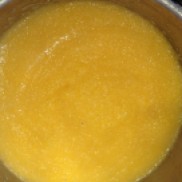Author/editor Licia Canton’s previous post on sbattutino was so widely read, we asked her back. She has delivered in the form of polenta and radicchio. Tutti a tavola dear readers.
Few people know that I am a writer with a backup plan. I put myself through school (all the way up to and including university) working in my parents’ butcher shop. I can handle several types of butcher’s knives. I can debone a pig’s head and make a variety of cuts out of a pork shoulder or a side of beef. I’ve always found solace knowing that, if times might get really tough and I wouldn’t be able to pay the bills by working with words, I could always seek employment in the meat department of a supermarket.
I grew up in a Venetian-Canadian family. My parents owned a butcher shop at the corner of Sabrevois and Rome streets in Montreal-North. We ate a lot of meat. Whatever was not sold ended up in our plates at dinnertime. Fillet mignon was a rare treat. We ate polenta and radicchio, staples in my parents’ hometown. It was my responsibility to prepare dinner after school and lunch every second Sunday. I made the meat sauce for the pasta, what we called el sugo. (Sauté onion and celery, then brown the minced or cubed meat; add salt, pepper and diced fresh or canned tomatoes; and let it simmer for one hour.) I was taught that every recipe takes a long time to make. Polenta, for instance, needed to be stirred nonstop. Years later, I found out that there is a shortcut to making polenta. Simply add salt to boiling water, add the cornmeal, put the lid on the pot and let the polenta cook by itself. No need to stir for 30-45 minutes. I could have gone outside to play while the polenta cooked itself had I known that the end product was the same. I am convinced that my parents taught me the long version because they wanted me to stay inside the house. Some nights, instead of having pasta or soup as a first course we had polenta e latte (milk). Once the polenta was ready, we added spoonfuls to a bowl of cold milk. The polenta warmed up the milk. It was like drinkable cornmeal.
In our vegetable garden, we mostly grew radicchio – our staple vegetable year round. We ate fresh red radicchio until the snow came. Then, we cooked and strained the radicchio, shaped it into balls and froze them. The dark green balls were taken out of the freezer, diced and sautéd in onion. It was rather bitter, but we ate it with meat, polenta, pasta al ragu and wine. My father made his own wine every September. He mixed several types of California grapes. Zinfandel was his favourite.
We children, too, were obliged to drink a quarter or an eighth glass of red wine at dinnertime. I closed my eyes and drank it right away so that I could move on to drinking something else. My sister did not drink anything during the meal: she always tried to leave the table without drinking the wine.
“Come back here, Ester,” my father would say after dinner, as she walked away from the table. “You have to drink the wine. You know that.” She’d go back and gulp it down and then run away.
When I was younger and had nothing to do (read, before my children were born), I liked to make my own pasta and gnocchi just like our mothers and grandmothers used to do. Nowadays, if my Calabrian-Canadian self-appointed chef husband-colleague insists on making dinner as a de-stressor, who am I to argue?
On the menu tonight, as a way of reconnecting to our roots: cooked radicchio, polenta and milk, and pasta al forno. (Not to be confused with lasagna or pasticcio, pasta al forno is a blend of cooked noodles, meat sauce and cheese. The mixture is laid out in a baking dish and cooked in the oven for about an hour or until the top is crusty).







Radicchio,this unfamiliar vegetable for Japanese,is really familiar one for you!
Last year in Italy,I was so amazed to see how to make “radicchio rosso ”
Your story is a very visually and hartearming.
I can easily imagine your sweet childhood!
LikeLike
Fabulous rich food descriptions. Makes my mouth salivate! And love the family story behind Licia Canton’s cooking experiences.
LikeLike